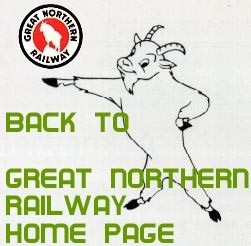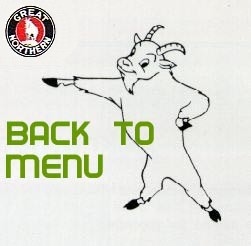|


| |
GN Electric Operations continued
OPERATION
POSITIONING OF CUT-OUT COCKS AND BRAKE
VALVE HANDLES
SINGLE UNIT OR LEAD UNIT IN MU SERVICE
The automatic brake valve handle on the inoperative
end should be removed in Running position. The independent
brake valve handle on the inoperative end should be
removed in Lap position. The double heading cock on the
operative end must be opened and on the inoperative end
must be closed (DH position). The controlled emergency
cock on the operative end must be either in "P" position
for passenger service or in "F" position for long freight
train service. The controlled emergency cock on the
inoperative end must be left in Lap position (handle off).
A cock handle is supplied on these brake valves, pinned to
the key, but the railroad may remove the pin if they so
desire and remove the handle along with the automatic
and independent brake valve handles when changing ends.
The signal line supply cock in the line to the brake valve
pedestal should be open only on the operative end. The
overspeed control cutout cock may be left open on both
ends under all circumstances of operation.
TRAILER UNIT IN MU SERVICE
The automatic brake valve handle on one end must be
removed in Running position, and on the other end must be
left in Running position. The independent brake valve
handle must be removed in Lap position at one end and
in the other end must be left in Lap position. The double
heading cock at both ends must be closed. The controlled
emergency cock at one end must be moved to "P" or "F"
position, depending upon the service, and left in Lap
(handle off) position at the other end. The signal system
supply cock must be closed at both ends.
Page 101
OPERATION
UNIT IN DOUBLE HEADING SERVICE
When the unit is used for double heading service any
place in the train, the automatic brake valve handle must
be removed in Running position at the inoperative end,
and the independent brake valve handle must be removed
in Lap position at the inoperative end. The double heading
cocks at both ends must be closed. The controlled
emergency cock should be in Lap (handle off) position at the
inoperative end, and in the "P" or "P" position, according
to the service, except when the locomotive is used at the
end of a long freight train. It should be placed in "P"
position for rear end pusher service. The signal line supply
cock should be closed at both ends.
DEAD HEADING
When the unit is hauled dead, the arrangement should
be the same as for a trailer unit in multiple unit service
except that the controlled emergency cock on one brake
valve should always be carried in "P" position. In addition,
the dead heading cock on the distributing valve must be
opened. The independent and automatic brake valve
handles may be staked in Running position at the brake valve
on which they are left.
Page 102
EMERGENCY OPERATION
A. OPERATING WITH TRACTION MOTORS CUT OUT
1. With One Pair of Motors Cut Out
No reduction in synchronous motor loading.
Traction motors may be operated continuously up
to 920 armature amperes in the high speed
connection.
2. With Two Pair of Motors Cut Out
Reduce synchronous motor loading to 1450
amperes.
Traction motors may be operated continuously up
to 1050 armature amperes.
3. With Three Pair of Motors Cut Out
Cut out one MG set.
Operate remaining MG set at full amperes.
4. With Four Pair of Motors Cut Out
Cut out one MG set and operate remaining set with
a load of 1450 amperes on synchronous motor.
Traction motors may be operated continuously up
to 920 armature amperes in the high speed
connection.
5. With Five Pair of Traction Motors Cut Out
Cut out one MG set and operate remaining set
with a load of 725 amperes on synchronous motor.
Traction motors may be operated continuously up
to 1050 armature amperes in the high speed
connection.
NOTE: If all motors in No. 2 end (7 thru 12) are cut out
the locomotive cannot be operated in separate
excitation.
B. OPERATING WITH BLOWERS CUT OUT
1. With One Transformer Blower Cut Out
Reduce synchronous motor loading to 1200
amperes.
Page 103
EMERGENCY OPERATION
Watch transformer temperature indicator,
limiting temperature rise to indicated safe values.
2. With Both Transformer Blowers Cut Out
Reduce synchronous motor loading to 600 amperes.
Watch transformer temperature indicator
limiting temperature rise to indicated safe values.
3. With Traction Motor Blowers 1AB or 2AB Shut
Down
a. Ventilation is removed from
Ml, M2 or Mil, M12 motors
No. 1 or No. 2 Motor Alternator Sets
No. 1 or No. 2 Compressors
No. 1 or No. 2 Control Compartment, including
the stabilizing resistors and synchronous motor
field resistors.
b. Method of Operation
The compressor not receiving ventilation should
not be permitted to run for more than 3 hours.
The motor alternator set not receiving
ventilation may supply power to blowers BB and TB
for a period of 60. minutes. The set must then
be shut down and the proper SGCO switch thrown
to cut out the starting generator and permit the
remaining starting generator to charge the
battery and supply the control load.
The traction motors (series excitation) not
receiving ventilation must be limited to the
following operation; 1050 amperes for 10 minutes or
600 amperes for 30 minutes.
In separate excitation, operation must be
limited as follows due to lack of ventilation for the
separate excitation resistors and traction motors.
Page 104
 
 
|